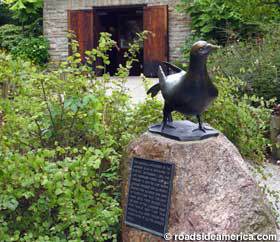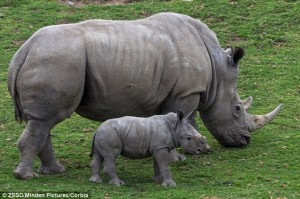Just thought I’d share a picture of Martha’s memorial still in Cincinnati’s Zoo. I highly doubt Martha looked nearly this happy.
Author: Brian Fogler
http://www.youtube.com/watch?v=cB_2nwNDSrQ
I discovered this video whilst searching “wild lions” on youtube. It immediately caught my eye because it combined two of my favorite things: soccer and lions. The video raises awareness about wild lions and their diminishing habitat, shows the amazing interaction humans and lions can share, and serves as an advertisement for a suit. The video opens with self-proclaimed lion expert Kevin Richardson explaining his personal history with lions which contained vast experience of protecting and bonding with lions. The video opens with Kevin receiving a huge bear hug by a male lion. The video continues with Kevin walking next to the lion in a long view shot that encompasses the landscape. Kevin narrates the problems lions have in today’s world, all the while showing his amazing control with lions. Eventually, a birds eye view of three lions and Kevin with an orange soccer ball appears and the foursome begin footballing. Kevin actually tries a few skills to get past the lion and the two lionesses, while the lions simply chew the ball. The music throughout the clip is very lion king-esque until the football scene where it becomes more uptempo and has an almost electronic connotation to it.
Not only did I find this video amazing, I found it to be completely relevant to Randy Malamud’s essay Zoo Spectatorship. Throughout his essay, Malamud has not a single positive thing to say about zoos. What Kevin does here (while it is not applicable to the other 99.99% of the world) is interact with wild lions. He does not simply look at them from a distance in an unnatural habitat, something that Malamud argues is distasteful and disrespectful to the animals. Kevin gets to experience the lions in their most natural state, and his interactions are able to get captured on video. While some may say it is a negative thing that Kevin is teaching these lions to be friendly towards humans while a large portion of humans approaching lions are poachers, I argue against it. I think his interactions with these lions can prove to humans that lions are kind, magical animals. Kevin also uses his videos to raise awareness about the diminishing habitat of the lions due to pollution and the dwindling population size because of increased poachers.
I appreciate this video because, as Malamud states, people should be “more concerned with what the imprisonment of animals says about the people who create, maintain and patronize zoos,” then the effect of zoos on the animals. (222). Kevin, like Malamud, would not appreciate zoos because they do not teach people the real lesson animals have to offer us. Kevin embodies Malamud’s ideas going against spectatorship. Animals are beautiful creatures and should be treated as such. The way Kevin involves himself with the lions goes against everything Malamud argues about zoos. The lions literally look into Kevin’s eyes, unlike in zoos where the “animals deflate the human gaze we conceive as so puissant, by cutting us in return – refusing to dignify or acknowledge our self-important ritual of looking.” (222). Everything Kevin did in this video proves how important it is to be involved with animals, not just spectate them.
Malamud, Randy. Zoo Spectatorship. New York: New York University Press, 1998. Print.
Another recurring problems I have encountered with my zoo research. Rhinos, who have some of the most sensitive sound throughout all of the Animal Kingdom, are finding it difficult to mate with all of the noise created by people in zoos. This is a pressing issue because the rate at which rhinos are getting poached is at an all-time high and it already is extremely hard to breed them.

I chose a peculiar image to look at for this blog post. The image is a frame of a cow with different sections outlined saying things like “no crowding” or “no antibiotics.” This is the wrapping the company whole foods uses for their ground beef. The cow shown has the outline of an actual cow one would use for beef, but it is nothing more than an outline and very distant from the Americanized cow one may think of. I will use Berger’s notion of animals of the mind and Foer’s ideas from Eating Animals to analyze this picture.
Whole foods isn’t trying to anthropomorphize this cow; it is not one of those cows one might see on television that talks about how happy they are and happy cows make better cheese. Then again, they are not trying to go around the fact that they indeed use this cow to sell its beef. Berger states “The animals of the mind, instead of being dispersed, have been co-opted into other categories so that the category animal has lost its central importance.” (Berger 15). What was once a Cow, is no longer viewed as a cow. According to Foer, 98% of cows are raised in crowded places without the ability to move. Cows in America were once treated as respected farm animals, living in a nice barn. In India, cows are sacred. They are now commodities, not Cow.
Although Whole Foods is famous for their organic food and well raised animals, Foer would have some things to say about that. Foer points out, all these terms have very loose definitions and very often mean little. None of these terms are actually defined and companies abuse them. More importantly, Foer talks about the antibiotics companies use to keep the meat safe and grow larger. This caused Humans to become so resistant to medicinal antibiotics because of the antibiotics in the food we eat. The growth hormones, according to Foer, make the meat bigger but is unsafe and not natural. Now Foer is very against over crowding and sensitive issues like that. I personally am not as concerned with that and while I appreciate what Whole Foods does this for the beef, I am much more concerned there antibiotic use.
Whole Foods does not try and appease its customers by anthropomorphizing the cow from the ground beef wrapping. It is a clear cut diagram of where the beef comes from and why Whole Foods is the best. The problem is, not many people can afford the costs and continue to buy antibiotic-rich beef at a cheaper cost. Not only does that affect them, it effects the entire population.
Sources:
Berger, John. “Why Look at Animals?” About Looking. New York: Pantheon, 1980. 3-28. Print.
Foer, Jonathan Safran. Eating Animals. New York: Little, Brown, 2009. Print.

![]() The first thing that came to my mind when thinking of a picture of an animal was Tony the Tiger. I will be drawing on Berger’s notion of humans anthropomorphization and viewing tigers as “Tiger”. Tony the Tiger is the 100% fictitious “front-man” for General Mills’ cereal Frosted Flakes, but the message he sends to kids and the comparisons I see between what he represents and Berger’s whole idea of animals of the mind, happens to be anything but fictitious.
The first thing that came to my mind when thinking of a picture of an animal was Tony the Tiger. I will be drawing on Berger’s notion of humans anthropomorphization and viewing tigers as “Tiger”. Tony the Tiger is the 100% fictitious “front-man” for General Mills’ cereal Frosted Flakes, but the message he sends to kids and the comparisons I see between what he represents and Berger’s whole idea of animals of the mind, happens to be anything but fictitious.
In this picture, Tony wears an embroidered ascot, has a very fit physique and a grin ear to ear. Everything about this image screams friendly, approachable character.
Every kid knows Tony the Tiger, and his catchphrase “they’reeeee greattttt!” Before reading Berger, I had thought of Tony to be just a funny, happy-go-lucky cartoon character. I venture to say, not only is Tony’s anthropomorphization from Berger’s notion of “Tiger” to something less animalistic is peculiar, it is a sign of the collapse on how humans look at animals.
All cereal brands use a mascot of sorts to reach out to kids. How does Tony the Tiger reach out to kids so well? The Tiger represents a fierce animal, every kid aged toddler and above knows what a Tiger is. The Tiger is one of the staples at zoos. Frosted Flakes could not use a natural Tiger as their mascot, that would turn kids off and scare them. They turned a fierce animal into an enthusiastic, baseball-playing, father-like figure. A Tiger, as a father-like figure.
Before Berger, I viewed this image as a friendly, unthreatening, fictitious being. Berger talked a lot about “animals of the mind.” Animals have been thrown out of their category as animal and thrown into categories such as families and spectacles. Berger continues to compare all animals now “appear like fish seen through the plate glass of an aquarium,” never seen in their natural habitat, just in human’s vision of their ideal home. In my opinion, showing a tiger in its natural habitat would just as much draw kids in as Tony the Tiger. Berger was all about looking at animals as their primal origins defined them as. A Tiger is a hunter, and a fierce competitor; it should be viewed as such.
Berger would call out General Mills on promoting the trend that people seem to follow these days; the trend being the practice of using/viewing animals as useful beings, and looking at them as commodities. If Tony the Tiger was just a normal, fresh out of the jungle tiger, Berger would have no problem with that. It’s merely the fact that in today’s world a cereal company needs to turn him into a human being that Berger would dislike. In not even three weeks of this class, it has taught me to think about the animal in a more holistic way then I have previously. It is not so much my views have changed, as much as now I am thinking more about the animals in a different context.
Hello class, my name is Brian Fogler. I am a junior economics major at Lafayette College. As a junior, I am involved in several on campus organizations. Those include: being a third year club soccer player, and being a member of the Delta Upsilon fraternity. I love watching most sports, mainly soccer and football. In addition to watching sports, one of my favorite things about Lafayette College is the great organization of the intramural sports pr ogram, which makes it fun to participate in.
ogram, which makes it fun to participate in.
I was born in Philadelphia, and raised in a town called Cherry Hill, New Jersey. My favorite family member by far is my dog Bazzle, a 13-year old Vizsla with a big heart.
I lived in Kamine Hall my freshman year, where I still maintain a good relationship with the great people who shared the same floor as me.
Over the summer I work at a day camp called Tall Pines Day Camp. I have been there for 14 years. I started as a camper and have worked there for the past seven years. For the last three summers, I have been in charge of 14-17 four and five year old boys. It is very rewarding to influence a younger generation, and all the hard work is worth it merely by the laughs I get each and every day from the outrageous things the kids say.
I am looking forward to garner a lot of writing skills throughout this class, as well as to make strong friendships with the rest of you. I wish the best of luck to all of you, and thank you for taking the time to read my blog.


Recent Comments